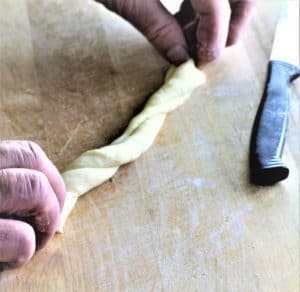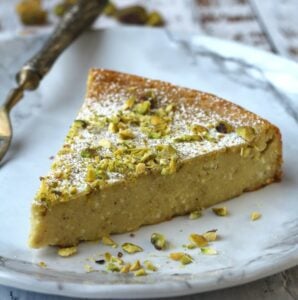Sweet Anise Taralli or scalille are a specialty from the Calabria region of Italy. Lightly scented with anisette liqueur and coated in a simple syrup, these taralli have an addictive chewy texture.

I'm so excited to finally share this recipe with you! These Sweet Anise Taralli have been on my to do list for years. I look forward to special occasions when my mother brings a mountain of them over to my house. They are highly addictive and it is impossible to stop at one!
A coffee cup full of oil...
In preparation for making Sweet Anise Taralli, I asked my mother for a list of ingredients. She began explaining: one handful of sugar per three eggs, one coffee cup full of oil, two coffee cups full of anisette liqueur and as much flour as needed..... you get the picture!
I'm still in awe at how Italian moms cook and bake flawlessly by using their hands as a unit of measure. I know I could never do that!
So once again I headed over to my mother's house and asked her to pour that handful of sugar into a measuring cup so I can carefully document this recipe. Somebody's gotta do it, right?

But, is it a Sicilian recipe?
Let me tell you a bit about the origins of this recipe. It's in fact not Sicilian at all, but my mother has made these ever since I could remember and we've adopted this recipe as our own. A close family friend who was from Calabria made them, my mother asked her for her recipe and this is her interpretation of that recipe.
When I posted a preview of my taralli, a dear reader immediately identified them as Scalille Calabresi! I was finally able to put an official name to them. However, our family friend called them taralli. That's how we've always called them at home and so I chose to name this recipe Sweet Anise Taralli.
The process of making these takes a little practice and patience. But let me assure you that even I, who has never made them before, got the hang of it after shaping the first four or five. Let me walk you through it.
How to make Sweet Anise Taralli:
Making the dough is actually a breeze. Simply combine your eggs, sugar, anisette liqueur, and vegetable oil in a large bowl. Mix well.

Next, stir in the flour and mix until the dough is smooth and quite stretchy and elastic, as shown:

Now you're ready to shape your taralli. Take note, the dough is VERY sticky, and this is normal. Have a small bowl with flour ready nearby. Take a spoon or forkful of dough and scrape it, using a knife, into the bowl of flour. Turn it over to coat the opposite side. Shake off excess flour.

Using the palms of your hand, by applying light pressure, begin to roll the dough into a rope of approximately 1 cm thickness and 30 cm long. If it is too sticky, lightly coat your hands with flour. If you are unable to roll the dough and it flattens instead, you probably have too much flour on the dough, your hands or both!

When the dough has reached the correct length, fold it in two, pinch the ends together and twist each end in the opposite direction two or three times. Join both ends to form a circle and pinch the ends together to seal.
Place on a prepared baking sheet covered with a clean tea towel. Proceed with the remaining dough.

Finally, fill a heavy bottomed pot (or use a deep fryer if you have one) with vegetable or canola oil and heat it. To verify if the oil is ready for frying, place the handle of a wooden spoon at the bottom of the pot. If the oil immediately begins to bubble and sizzle around it, it's ready. A cool trick that my mom taught me!
Place four or five taralli in the hot oil (depending on the size of your pot), without overcrowding them. When they float to the top of the oil, flip them and brown the opposite side. This will take approximately 3-4 minutes. When golden in color transfer to a paper towel covered plate to cool.

To glaze: prepare a simple syrup by bringing sugar and water to a boil. Simmer for about 5 minutes. Let cool for a few minutes and then dredge each taralli, one at a time in the syrup and place on a serving platter. You can also give them a light sprinkling of granulated sugar.
Tips and suggestions:
- If you can not find Anisette liqueur, you can use Anice or Sambuca. These are all anise based liqueurs.
- The dough will be very sticky. Remember to lightly flour the dough, your hands and your work surface before rolling otherwise it will tend to flatten instead of rolling.
- You can also cut the dough into small pieces and roll into doughnut hole shaped taralli.
- The fried taralli will keep for several days at room temperature in a well sealed container.
- Alternately, you can freeze the final glazed taralli.
A final word of warning, these taralli are highly addictive! You will find yourself making detours to the kitchen to grab just one more, especially if you make the small bite sized ones. When you make these, please do tag me with @mangiabedda or #mangiabedda on Facebook or Instagram so I can see them. Feel free to share this post with your friends on social media as well! Buon appetito!


Sweet Anise Taralli
Ingredients
- 6 large eggs
- ½ cup granulated sugar
- 1 cup Anisette liqueur
- ½ cup vegetable oil
- vegetable oil, for frying
- 4 cups all-purpose flour, plus extra for dredging
For simple syrup
- ½ cup granulated sugar
- 1 cup water
- granulated sugar, optional for sprinkling
Instructions
- In a large bowl, add the eggs, sugar, Anisette, and oil. Mix well.
- Gradually pour in the flour, stirring until it is well combined. Stir until the dough is smooth and elastic
- Prepare a small bowl with about ½ cup of flour. Use a spoon or fork to scoop a piece of dough and scrape into the bowl of flour with a knife. Flip the dough over to lightly coat the opposite side with flour. Shake off excess flour.
- On a clean, lightly floured surface, begin rolling the dough by applying light pressure with the palms of your hands. Roll into an approximate 1 cm thick rope of about 30 cm long.
- Fold the rope in half, pinch both ends together and twist each end in the opposite direction. Form a circle by pinching both ends together to seal. Place on a prepared baking sheet covered with a tea towel. Repeat with remaining dough.
- You can also make small doughnut whole shaped taralli by cutting 3 cm pieces of dough and rolling into small balls.
- Slowly heat vegetable oil in a heavy bottomed pot filled halfway with oil. When the oil is hot, fry 4-5 taralli at a time. Do not overcrowd the pot. When they float to the surface and have browned lightly, flip and brown the opposite side. This will take 3-4 minutes
- Place in paper towel covered plate to soak up excess oil.
- Prepare a simple syrup: Bring sugar and water to a boil in a medium sized sauce pan. Cook for 5 minutes. Let cool.
- Carefully dredge the fried taralli in the simple syrup and place on a serving platter. If desired, sprinkle lightly with granulated sugar.
Notes
- If you can not find Anisette liqueur, you can use Anice or even Sambuca. These are all anise based liqueurs.
- The dough will be very sticky. Remember to lightly flour the dough, your hands and your work surface before rolling otherwise it will tend to flatten instead of rolling.
- You can also cut the dough into small pieces and roll into doughnut hole shaped taralli.
- The fried taralli will keep for several days at room temperature in a well sealed container.
- Alternately, you can freeze the final glazed taralli.
- Please note that nutritional information is approximate and may vary depending on the size of your taralli and the amount of oil absorbed during frying.
Nutrition








Rachel
This recipe sounds so good. I would like to try it, but I'm not sure if I can find anisette liquour in France. Would Pastis work? It's definitely licorice/anise flavored. Thanks!
Nadia
Hello Rachel, anisette liquor is not always easy to find however since Pastis also has a licorice like flavor it should work well. Let me know how they turn out!
Jess
These look amazing. Do you think this recipe will work with fennel seeds and make them savory.
Nadia
Hi Jess, these are soft and chewy and meant to be sweet therefore I would not add fennel to them. I would recommend my savory taralli recipe to which you can add fennel seeds if you wish. You'll find that her: https://www.mangiabedda.com/white-wine-taralli/. Hope this helps and thanks for your question!
Jess
Thank you so much.
The only issue is my oven is broken, and I'm craving these, Do you think I could fry them.
A Napolitano just craving taralli
Nadia
Hi Jess, it's too bad about your even! As for the frying, I think you're asking about the taralli? Unfortunately I have never heard or tried fried taralli before so I'm not sure how they would turn out. Hope your oven gets fixed soon!
Jon Orendorff
Our family makes almost the same things and even the origin story is the same - got it from a family friend - but we dust in powdered sugar after coming out the oil. Our twists tend to be long rather than round. Some will bake to avoid so much oil but they taste best fried. Great with coffee.
mangiabedda@gmail.com
Hi Jon, I haven't met many people who know this recipe so thanks for sharing this with me. You're definitely right about them being better fried! Thanks for stopping by my blog!
Joshua Fazio-Mariani
Fantastic!
mangiabedda@gmail.com
Thanks!
Frank
My paternal grandmother—from the interior of Campania—made cookies very similar to these, only baked rather than fried. I make them from time to time when the mood strikes. Next time I'll try frying them!
mangiabedda@gmail.com
Actually now I think I’d like to try baking them too! Do you put a glaze on them?
Felicia Barosa
Can you tell me about the baking method please
mangiabedda@gmail.com
Hi Felicia, I have not tried baking them but I don't think it would be difficult. I would place them on a parchment covered baking sheet and bake at 350F until they are golden and then dip them in the simple syrup once they come out of the oven and cooled a bit. Hope this helps!
Nicoletta De Angelis Nardelli
Those are super yummy! I can see why they are addictive 🙂 . I always love learning about sweets I've never heard of, even being from Italy. Every Region has so many jewels to share with the world. Thanks, Nadia!
mangiabedda@gmail.com
Hi Nicoletta, of course anything fried is so yummy! I was glad to finally put a name to this specialty from Calabria. So many more recipes to learn. Thanks for your comment!